
Coventry is a town in Kent County, Rhode Island, United States. The population was 35,688 at the 2020 census and is part of the Pawtuxet River Valley.

Cranston, formerly known as Pawtuxet, is a city in Providence County, Rhode Island, United States. The official population of the city in the 2020 United States Census was 82,934, making it the second-largest city in the state. The center of population of Rhode Island is located in Cranston. Cranston is a part of the Providence metropolitan area.

Itri is a small city and comune the province of Latina, Lazio, central Italy.

Fiskeville is a small village in the south west corner of Cranston, Rhode Island, United States, the south east corner of the Town of Scituate, Rhode Island and across the northern side of Coventry, Rhode Island. The village's Main Street forms the border between Cranston and Scituate. Fiskeville grew up as one of several mill towns along the Pawtuxet River in the mid-1800s. The Fiskeville textile mill was formed by Dr. Caleb Fiske, a Revolutionary War doctor turned businessman in 1812. The village became home to those who worked in the mill, mostly immigrants from Portugal, France, Italy and England. Fiskeville is usually associated with Cranston rather than with Scituate as most of the original buildings including Dr. Fiske's residence were in Cranston. Although the mill and about a dozen nearby mill houses were in Scituate. Poets Karen Haskell and Darcie Dennigan both grew up, a few doors down from each other, in the 1970s and 1980s on Main Street in Fiskeville.

Thornton is a neighborhood located in the north-west part of Cranston, Rhode Island on the Johnston line and extends into the Johnston side.
Saint Paul School is a Catholic, co-educational, elementary school in Cranston, Rhode Island, United States. It serves students from the cities of Cranston, Warwick and Providence in Rhode Island, USA.

Federal Hill is a neighborhood in Providence, Rhode Island. It lies immediately west of the city's Downtown, across Interstate 95. Since the late 19th century, Federal Hill has been an enclave of Providence's Italian American community; today the neighborhood is noted for its abundance of Italian restaurants, markets, and cultural establishments.

The Episcopal Diocese of Rhode Island is a diocese of the Episcopal Church in the United States of America, encompassing the state of Rhode Island. It is one of seven New England dioceses that make up Province 1.
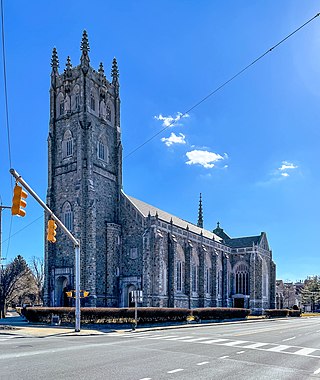
Saint Paul Church, located in Cranston, Rhode Island, is a church and parish of the Diocese of Providence.
Norwood is a neighborhood in the city of Warwick, Rhode Island. Norwood is bounded by Route 37, the Pawtuxet River, Elmwood Avenue, and Post Road. Such borders mark the area traditionally served by the fire station previously located at the current site of the Norwood Boys & Girls Club.
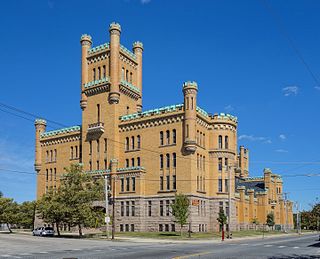
The West End is a neighborhood in the southwestern part of Providence, Rhode Island in the region often referred to as the South Side. Its boundaries are delineated by Westminster Street to the north, Huntington Avenue to the south, Elmwood Avenue to the east and the railroad tracks with Route 10 to the west. Cranston Street runs through the center of West End, past the Cranston Street Armory which has given the neighborhood the alternative name of the "Armory District."
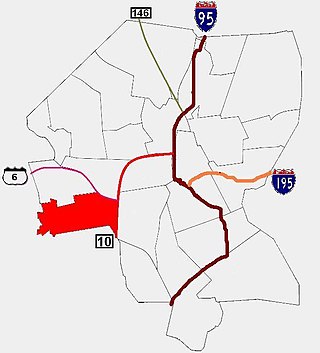
Silver Lake is a neighborhood on the western edge of Providence, Rhode Island. It is bordered by the Hartford neighborhood to the north, Route 10 to the east, Johnston and Cranston on the West and separated from Olneyville by Route 6.
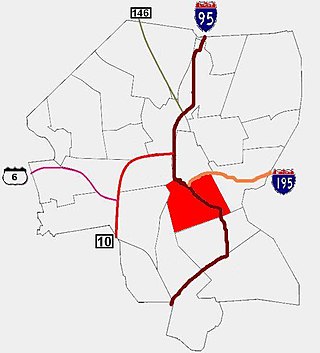
Upper South Providence is an official neighborhood in the South Side in the city of Providence, Rhode Island. It is bound to the north by Interstate 95, the east by the Providence River, to the south by Public Street, and the west by Broad Street. Often associated with Lower South Providence directly to its south, Upper South Providence is a distinct neighborhood.
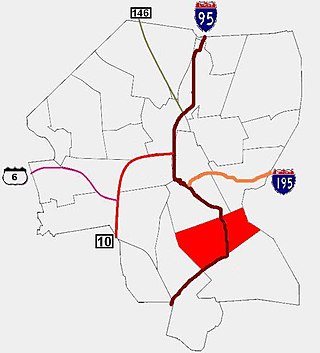
The Lower South Side is a neighborhood in the southern part of Providence, Rhode Island. It is bounded by Public Street to the north, by Interstate 95 to the south, by Broad Street to the west, and by the Providence River to the east.

The Tavern Hall Preservation Society is a not-for-profit corporation dedicated to the preservation and upkeep of the Elisha Reynolds House (1738) in Kingston, Rhode Island. The society was founded as the Tavern Hall Club in 1911 to foster understanding and cooperation between the people of the Village of Kingston and the nearby Rhode Island State College community.

St. Mary's Church, officially the Church of the Holy Name of Mary, Our Lady of the Isle, is a historic Catholic parish church complex at 14 William Street, the corner of Spring Street and Memorial Boulevard, in Newport, Rhode Island within the Diocese of Providence. It is the church of the oldest Catholic parish in the state. The church is also notable for hosting the wedding of Jacqueline Bouvier and Senator, later President, John F. Kennedy in 1953.

Ambrose J. Murphy (1869–1949) was an American architect whose practice was based in Providence Rhode Island. He was a specialist in ecclesiastical work and, in a career that spanned over 40 years, designed many buildings for the Roman Catholic Diocese of Providence Rhode Island and Fall River Massachusetts.
Frances Latham (1610–1677), was a colonial American woman who settled in Rhode Island, and is known as "the Mother of Governors." Having been widowed twice, she had three husbands, and became the ancestor of at least ten governors and three deputy/lieutenant governors, and is related by marriage to an additional six governors and one deputy governor.
Edward Wilcox (1751-1838) was an American politician who was Lieutenant governor of Rhode Island from 1817 to 1821. He briefly served as governor of Rhode Island following the resignation of Nehemiah R. Knight on January 9, 1821, until his successor took office on May 2, 1821.















